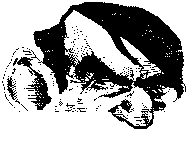|
[images
added by this website]

Tuesday, June 8, 2004
Ban on torture
overruled in Pentagon
By David Rennie in Washington
(Filed: 08/06/2004)
A LEAKED Pentagon memo cast
serious doubt yesterday on the Bush
administration's insistence that its treatment of
prisoners was bound by laws and treaties banning
torture.
A secret document discloses that, on the eve of
the Iraq war, political appointees overruled
military lawyers to assert that President George
W Bush was not bound by US and international
law on torture.

David
Irving comments:
ALL this is
sickeningkly similar to the history of
Adolf Hitler's attack on
Russia.
During the months
before that operation, Barbarossa,
his military legal experts debated what
measures could be taken against captives,
and a Hitler decree on
Militärgerichts- barkeit
(application of military laws) was issued,
signed by Field Marshal Wilhelm
Keitel and Generaloberst Alfred
Jodl.
The decree effectively
guaranteed immunity in advance for any
German officers accused of atrocities.
Keitel and Jodl were
executed by an American hangman at
Nuremberg in October 1946). 
|
The memo, prepared for Donald Rumsfeld, the
defence secretary, went on to claim that, if
national security was at stake, government agents
who tortured or even killed prisoners on the
president's authority were immune from
prosecution.
A draft of the 100-page memo, leaked to the
Wall Street Journal, conceded that several
US and international laws banned torture. But
lawyers at the Pentagon and the justice department
argued that all such treaties and laws were trumped
by the president's "inherent constitutional
authority to manage a military campaign" and
protect the American people.
The leak appears to be part of an extraordinary
civil war in the Pentagon between civilian
officials and uniformed officers appalled by what
they have described as moves by political
appointees to shroud the war on terrorism in an
"environment of legal ambiguity".
The trail of the memo begins at
Guantánamo Bay and leads to Baghdad's Abu
Ghraib prison, where pictures of abused and
humiliated prisoners shocked the world.
A military official who helped to prepare the
report told the Journal that the memo was
requested by senior commanders at
Guantánamo. They had complained in late 2002
that conventional interrogation methods were not
extracting valuable information from terrorist
suspects. The official said: "People were trying
like hell to ratchet up the pressure."
Techniques then used at Guantánamo
included drawing on a prisoner's body and placing
women's underwear on prisoners' heads. Those
practices appeared in abuse photographs from Abu
Ghraib, casting doubt on the Bush administration's
insistence that Abu Ghraib misconduct was the work
of a few low-level "bad apples".
An intelligence officer told the Journal
that methods now used at Guantánamo
included
- limiting prisoners' food,
- subjecting them to body searches,
- depriving them of sleep for up to 96 hours
and
- shackling them in stress positions.
In public, William Haynes, the Pentagon's
senior civilian lawyer, insists that all
interrogations are conducted in a manner
"consistent with" the international convention on
torture.
Mr Haynes was in charge of the working group
that drew up the memo, officials told the
Journal, and political appointees claimed
almost unlimited powers for the president to
approve torture.
America and Britain issued a fourth draft last
night of a United Nations resolution granting Iraq
sovereignty as they pressed for a vote at the
Security Council as early as tonight. It ignores
French demands for an explicit Iraqi veto over
military operations but pledges "close
co-ordination" between coalition forces and the new
interim administration.
© Copyright of
Telegraph Group Limited 2004.

 Abu
Graib case
Abu
Graib case
|